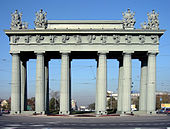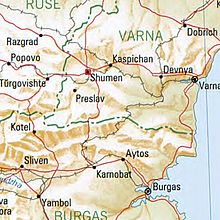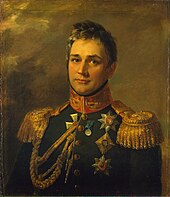Russo-Turkish War (1828–1829)
The Russo-Ottoman War 1828–1829 was fueled by the Greek struggle for independence , which Russia supported as an orthodox-Christian protecting power despite its liberal orientation .
prehistory
Tsar Nicholas I supported the Greeks' struggle for freedom against the suzerainty of the Ottoman Empire . Negotiations with the English ambassador, the Duke of Wellington , in Saint Petersburg on April 4, 1826 , led England to act as a mediator in the conflict between the Sublime Porte and the Greeks. On March 17, 1826, the tsar sent a sharp note to Sultan Mahmud II, demanding the restoration of the old legal status of the Danube principalities and the strict recognition of the autonomy of Serbia . In May the Porte agreed to negotiations in the border town of Akkerman on the Dniester , whereupon negotiations began in August. In the Akkerman Convention of October 7, 1826, the Turks gave in to pressure and had to confirm the Russian demands.
In the London Treaty, signed on July 6, 1827, the United Kingdom, France and Russia agreed to call for an armistice in preparation for a final settlement of the Oriental question. When this demand arrived at the gate in August 1827 and remained unanswered, an Allied fleet was dispatched to the Ionian Sea . The participation of Russian associations in the Battle of Navarino (October 20, 1827) angered the Ottoman Sultan so much that he closed the Bosporus to the passage of Russian ships and on November 30, 1827 canceled the Akkerman Agreement, whereupon the Russian Empire opened the gate declared war on April 14 (26), 1828.
course
Campaign of 1828
When fighting broke out, the Russian army consisted of 92,000 men and faced an Ottoman force of around 150,000 men under the command of Hussein Pasha .
At the end of April 1828, the Russian army gathered in Bessarabia, the IV Cavalry Corps (General Borosdin) was expected from the Kursk area for the end of May. First, the Russian field marshal occupied Graf zu Sayn-Wittgenstein the Wallachia and Bucharest . Meanwhile, the III. Corps under General Rudzewitsch on May 27 at Satunow (between Reni and Ismael) crossed the Danube in front of the present Tsar Nicholas I and occupied the entire northern Dobruja . The VII Infantry Corps under General Woinow, later under the Duke of Württemberg , took the fortress of Brăila without much effort until June 7th .
At the same time, a large part of the VI. Corps under General Roth relocated to the Danube to begin the siege of Silistria . The remaining parts of VI. Corps (a weak division under General Fyodor Geismar ) stayed in Wallachia for the time being and secured the right wing by observing the fortresses Nikopol and Widdin .
At the end of June the III. and VII. infantry and the IV. cavalry corps in space Pazardzhik and sent the avant according Kozludscha and Varna advance. After that, at the beginning of July, the Russians began to siege the key Bulgarian fortresses of Shumla (Shumen) and Varna . The siege of Varna was entrusted to Count Vorontsov , who initially had 12,000 men and 47 cannons, but was increased to 32,000 men after the arrival of the Guard Corps (under Grand Duke Michael Pawlowitsch ). For the relief of Varna, the Grand Vizier sent a 30,000-strong corps under Mehemed Selim and Omer Vrioni Pascha, which was repulsed on September 20 by troops of the Prince of Württemberg near Kurtepe. On September 29, Varna was more closely enclosed by the Russians. With the help of the Black Sea Fleet under Admiral Heiden and Greigh, Varna could on September 28th July. / October 10, 1828 greg. be taken. The siege of Shumla proved more difficult, as the 40,000-strong Ottoman garrison in the city far outnumbered the Russians. In addition, other Ottoman associations could disrupt the Russian supply lines considerably. The resulting famine and the spread of disease in the Russian camp killed more soldiers among the Russians than through fighting during the entire war. The Count of Wittgenstein wanted to lift the siege of Shumen, but Nicholas I did not allow him to withdraw immediately. Operations under the walls of Silistria went just as badly. The corps of General Roth (9000 men with 28 guns) could not completely enclose the fortress, the garrison of which from Ruschuk was constantly reinforced. The first siege of Silistra had to be lifted on October 27th. Before the onset of winter, the Russian army also had to leave the walls of Shumen and retreat to Bessarabia .
War events in Anatolia
The army of Prince Ivan Paskewitsch , operating on the Caucasian front, was able to achieve significant successes against the Turks despite great numerical inferiority. The Russian fleet under Admiral Greigh captured Anapa on June 28 and landed reinforcements under Prince Menshikov from mid-July . Paskiewitsch invaded Asian Turkey on June 26, 1828 and stormed the fortress of Kars on July 6 . His troops took on August 3, Akhalkalaki, August 22, the Turkish troops under Kiossa Pasha were in Akhaltsikhe defeated and occupied this place the following day. On August 28, the Doğubeyazıt fortress was captured by troops under Prince Chavchavadze , and a second Turkish army was defeated at the sources of the Euphrates . The Russian national poet Alexander Pushkin , who later dedicated his works to Paskevich , was also in the Russian army .
For the continuation of the campaign, larger supplies had to be brought in before operations against the Serasker of Erzurum , Salegh Pascha, could begin in 1829 . On August 9, Paskevich entered Erzurum in northeastern Anatolia .
Campaign of 1829
In February 1829, the 60-year-old Sayn-Wittgenstein, whose caution in military planning was criticized by many as excessive, was replaced by the more energetic Hans Karl von Diebitsch , while the Tsar returned to Saint Petersburg . On February 16, 1829, the port city of Sozopol (→ Battle of Sozopol ) was captured by the Russian fleet. At the end of May, units under Admiral Heiden began to block the straits near Constantinople and interrupted all ship deliveries.
On May 7, 1829 von Diebitsch crossed the Danube again with 60,000 men and continued the siege of Silistria . The Sultan sent an army of 40,000 men to reinforce Silistria. However, these troops were destroyed by Diebitsch in the Battle of Kulewitscha on May 30th. A few weeks later, on June 18, the Silistria fortress fell to the Russians, with 9,300 prisoners and 253 guns brought in.
On July 2, 1829, Diebitsch began a surprising offensive over the Balkan Mountains , the first in Russian military history since the last intervention of Svyatoslav I in the 10th century. A contingent of 35,000 Russians and Bulgarian volunteers crossed the Bulgarian mountains and marched directly towards Constantinople . The army was divided into two columns for the advance - on the right wing stood the VII. Corps under General Fjodor Rüdiger , the left formed the VI. Corps under General der Infanterie Roth , followed by the II. Corps under Count Pahlen as a reserve together with the Commander-in-Chief. On July 12, Burgas fell, and on July 31, another Ottoman corps was defeated near Sliven . On August 28, the Russians were already in Adrianople , 60 km from Constantinople. Panic broke out on the streets of the Ottoman capital.
End and peace

Sultan Mahmud II had no choice but to seek peace. The peace treaty was signed in Adrianople on September 14, 1829. With the Treaty of Adrianople , Russia was granted most of the east coast of the Black Sea and the Danube Delta . The Ottoman Empire recognized Russian supremacy over Georgia and present-day Armenia . Serbia achieved autonomy and Russia was allowed to occupy Moldova and Wallachia until the Turks paid high war reparations. The question of passage through the Dardanelles was regulated four years later in the Treaty of Hünkâr İskelesi .
Diebitsch was raised to the rank of count for his success on August 11, 1829 and was honored with the addition of Sabalkanski (German: Überreiter des Balkans ). When the Russian troops withdrew from the Gulf of Burgas , several thousand Bulgarians also fled. It is estimated that up to 100,000 Bulgarians settled in the areas allocated to the Russian Empire by the Treaty of Adrianople, such as Bessarabia .
Web links
swell
- Османская империя: проблемы внешней политики и отношений с Россией. М., 1996. (The Ottoman Empire: Problems in Foreign Policy and Relations with Russia. Moscow, 1996)
- Шишов А.В. Русские генерал-фельдмаршалы Дибич-Забалканский, Паскевич-Эриванский. М., 2001. (Schischow, AB The Russian field marshals Dibitsch-Zabalkanskij and Paskewitsch-Erewanskij. Moscow, 2001)
- Шеремет В. И. У врат Царьграда. Кампания 1829 года и Адрианопольский мирный договор. Русско-турецкая война 1828–1829 гг .: военные действия и геополитические последствия. - Военно-исторический журнал. 2002, № 2. (Sheremet, WI At the gates of Constantinople. The campaign of 1829 and the peace of Adrianople. Russo-Turkish war of 1828–1829: acts of war and geopolitical consequences. Military-historical journal, 2002, No. 2)






